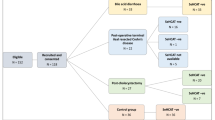Abstract
Bile acids are believed to play a role in the etiology of colorectal cancer. To examine the relationship between bile acids and colorectal neoplasia, bile acids in colon residual liquid or fecal material were analyzed in 18 patients with colorectal adenoma, 12 patients with colorectal cancer, and 18 healthy control subjects. High-performance liquid chromatography combined with immobilized 3α-hydroxysteroid dehydrogenase in column form showed a significant evevation in the proportion of deoxycholic acid (P<0.05), lithocholic acid (P<0.05), secondary bile acids (deoxycholic acid plus lithocholic acid) (P<0.02), and the chenodeoxycholic acid-lithocholic acid family (chenodeoxycholic acid plus lithocholic acid) (P<0.05) in the colon residual liquid or fecal material of the patients with colorectal adenoma compared with proportions in the control subjects. A similar trend was noted in the patients with colorectal cancer compared to the control subjects. These findings suggested that an increase in the proportion of secondary bile acids, in particular, of lithocholic acid, was closely related to the pathogenesis of colorectal neoplasia.
Similar content being viewed by others
References
Cohen BI, Raicht RF, Deschner EE, et al. Effects of cholic acid feeding on N-methyl-N-nitrosourea-induced colon tumors and cell kinetics in rats. J Natl Cancer Inst 1980;64:573–578.
Tanida N, Sawada K, Kawahara A, et al. Effect of oral administration of sulfo-lithocholic acid disodium salt and lithocholic acid sodium salt on N-methyl-N-nitrosourea-induced colonic tumorigenesis in conventional rats. Cancer Res 1989;49:1178–1181.
Narisawa T, Magadia NE, Weishburger JH, et al. Promoting effect of bile acids on colon carcinogenesis after intrarectal instillation of N-methyl-N′-nitro-N-nitrosoguanidine in rats. J Natl Cancer Inst 1974;53:1093–1097.
Reddy BS, Narisawa T, Maronpot R, et al. Animal models for the study of dietary factors and cancer of the large bowel. Cancer Res 1985;35:3421–3426.
Reddy BS, Watanabe K, Weisburger JH, et al. Promoting effect of bile acids in colon carcinogenesis in germ-free and conventional F344 rats. Cancer Res 1977;37:3238–3242.
Cummings JH, Wiggins HS, Jenkins DJA, et al. Influence of diets high and low in animal fat on bowel habit, gastro- intestinal transit time, fecal microflora, bile acid, and fat excretion. J Clin Invest 1978;61:953–963.
Wynder EL, Reddy BS. Diet and cancer of the colon. Curr Concepts Nutr 1977;67:55–71.
Reddy BS, Wynder EL. Metabolic epidemiology of colon cancer: Fecal bile acids and neutral sterols in colon cancer patients and patients with adenomatous polyps. Cancer 1977;39:2533–2539.
Moskovitz M, White C, Barnett RN, et al. Diet, fecal bile acids, and neutral sterols in carcinoma of the colon. Dig Dis Sci 1979;41:923–928.
Murray WR, Blackwood A, Trotter JM, et al. Faecal bile acids and clostridia in the aetiology of colorectal cancer. Br J Cancer 1980;41:923–928.
Tanida N, Hikasa Y, Shimoyama T, et al. Comparison of faecal bile acid profiles between patients with adenomatous polyps of the large bowel and healthy subjects in Japan. Gut 1984;25:824–832.
Hikasa Y, Tanida N, Ohno T, et al. Faecal bile acid profiles in patients with large bowel cancer in Japan. Gut 1984;25:833–838.
Breuer NF, Dommes P, Jaekel J, et al. Fecal bile acid excretion pattern in colonic cancer patients. Dig Dis Sci 1985;30:852–859.
Breuer NF, Jaekel S, Dommes P, et al. Fecal bile acids in patients with adenomatous polyps of the colon. Digestion 1986;34:87–92.
Geltner-Allinger U, Brismar B, Reinholt FP, et al. Soluble fecal acidic lipids and colorectal epithelial cell proliferation in normal subjects and in patients with colon cancer. Scand J Gastroenterol 1991;26:1069–1074.
Owen RW, Thompson MH, Hill MJ, et al. The importance of the ratio of lithocholic to deoxycholic acid in large bowel carcinogenesis. Nutr Cancer 1987;9:67–71.
Moorehead RJ, Campbell GR, Donaldson JD, et al. Relationship between duodenal bile acids and colorectal neoplasia. Gut 1987;28:1454–1459.
Taguchi F. Analysis of duodenal bile acids among patients with colorectal tumor and control subects. J Nippon Med Sch 1995; 62:588–595.
Van der Werf SDJ, Nagengast FM, Van Berge Henegouwen GP, et al. Colonic absorption of secondary bile acids in patients with adenomatous polyps and matched controls. Lancet 1982;I:759–762.
Dukes CE. The classification of cancer of the rectum. J Pathol Bact 1932;35:323–332.
Brown GR. A new approach to colon preparation for barium enema. Univ Michigan M Bull 1961;27:225–230.
Okuyama S. Analysis of free, glycine- and taurine-conjugated individual bile acids using high-performance liquid chromatography and immobilized 3α-hydroxysteroid dehydrogenase in column form. Jpn J Clin Pathol 1981;29:446–458.
Setchell KD, Gilbert JM, Lawson AM. Fat and cancer (letter). BMJ 1983;286:1750.
Bayerdörffer E, Mannes GA, Richter WO, et al. Increased serum deoxycholic acid levels in men with colorectal adenomas. Gastroenterology 1993;104:145–151.
Malagelada JR, Go VLW, Summerskill WHJ, et al. Bile acid secretion and biliary bile acid composition altered by cholecystectomy. Am J Digest Dis 1973;18:455–459.
Mastromario AJ, Reddy BS, Wynder EL. Fecal profiles of anaerobic microflora of large bowel cancer patients and patients with nonhereditary large bowel polyps. Cancer Res 1978;38:4458–4462.
Shimada K. Enterohepatic circulation and intestinal flora. Taisha (in Japanese) 1973;10:847–854.
Van der Werf SDJ, Nagengast FM, Van Berge Henegouwen GP, et al. Intracolonic environment and the presence of colonic adenomas in man. Gut 1983;24:876–880.
Kubota Y. Fecal intestinal flora in patients with colon adenoma and cancer. Jpn J Gastroenterol 1990;87:771–779.
Reddy BS. Diet and excretion of bile acids. Cancer Res 1981;41:3766–3768.
Reddy BS, Engle A, Simi B, et al. Effect of dietary fiber on colonic bacterial enzymes and bile acids in relation to colon cancer. Gastroenterology 1992;102:1475–1482.
Author information
Authors and Affiliations
Rights and permissions
About this article
Cite this article
Kishida, T., Taguchi, F., Feng, L. et al. Analysis of bile acids in colon residual liquid or fecal material in patients with colorectal neoplasia and control subjects. J Gastroenterol 32, 306–311 (1997). https://doi.org/10.1007/BF02934485
Received:
Accepted:
Issue Date:
DOI: https://doi.org/10.1007/BF02934485




